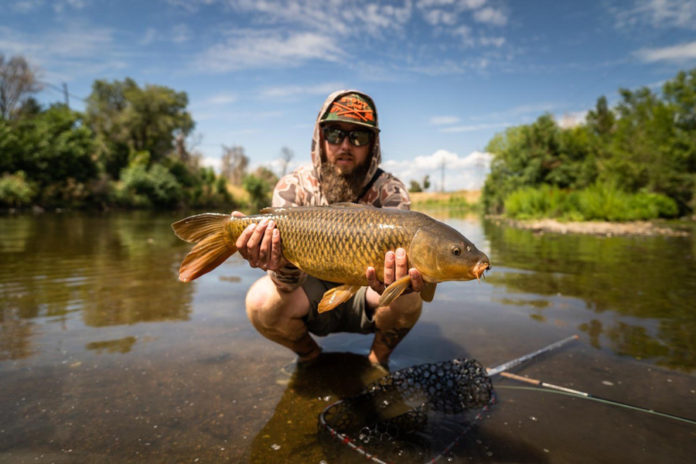Written by: Rick Mikesell, Trout’s Fly Shop
Twenty-five years ago, angling pioneers Barry Reynolds, Brad Befus, and John Berryman published Carp on the Fly, setting the stage for a major shift in fly-fishing culture and elevating the lowly carp from trash fish to revered quarry. I was fortunate enough to stumble into fly fishing during that same fateful era in Denver, crossing back and forth across the South Platte daily and quickly becoming obsessed with their version of the sport.
Thanks to the blueprints these anglers created, I was able to smoothly navigate the nuances and unique demands of fishing for carp in moving water. It wasn’t until many years later–after the carp community had become better-established and more widespread–that I realized both the setup and the techniques I had learned to use on the South Platte were quite different from those my peers were using elsewhere in the country. Below is a detailed description of how my setup for carp in moving water differs in terms of fly design and leader construction. In Part II, I will describe two specific presentation techniques.

Fly Design
When I took over buying for Trout’s Fly Shop, I was determined to have the most complete carp-fly selection in the country. As I scoured patterns from various manufacturers, however, a common problem soon emerged: most carp-specific patterns were too lightweight for the river. They had been designed for still waters, designed to achieve minimal splash and a slower sink rate, both of which help to avoid spooking these notoriously sensitive fish. In the river, however, these lightweight designs often drifted right over fish sitting in current, never even reaching the strike zone.
Fortunately, there are plenty of heavily-weighted carp flies these days, along with effective crossover patterns from both the saltwater world and the new frontier of Euro-nymphing. The Euro-style patterns are quickly becoming favorites because they address another important factor in sink rate: drag. In the Euro world, the goal is to get the fly down as quickly as possible to maximize your drift through the strike zone, so these flies are tied with slim profiles and sleek materials in order to avoid excess drag in the water. They cut through the current and hit the bottom quickly, placing them in the feeding window with minimal lateral travel.
In terms of specific patterns, it’s hard to go wrong with Barry’s Carp Fly, a classic designed by Mr. Reynolds himself. It’s heavy, cuts through the water quickly, and has a ton of action. Over the past few years, my go-to pattern has been the Tungsten Jigged Bugger. This simple but deadly fly features a heavy bead, slim body to reduce drag, and a profile that mimics almost everything a carp could want to eat. When it comes to Euro-style flies, I like the Tactical Prince Jig. This new twist on a time-honored pattern in size 8 or 10 is great when fish are being picky and spooking from larger offerings.
Leader Construction
In most introductory carp-fishing articles, the authors suggest starting with a 9-foot leader, then adding tippet to extend it to 11-12 feet, with some extremes going to more than 15 feet. When fishing for carp in still water, this design helps to avoid spooking fish with the fly line during false casts and after delivery. But in moving water, especially on the Denver South Platte, a 15-foot leader would be an absolute nightmare to deal with for two reasons:
First, long casts are actually a hindrance on the river due to water clarity, small feeding zones, and complex currents. Carp have excellent motion detection in their periphery, and multiple false casts will almost always turn the fish off, or worse yet, spook them completely. The most productive approach is to carefully sneak up on the fish and get as close as possible, often only a rod-length away, to make your presentation. But a 15-foot leader would still be inside the guides, and given how explosive a carp’s initial run can be, the standard loop-to-loop connection between leader and fly line can easily get caught in the guides and pull the tip section off your rod during the fight.

A second disadvantage to long leaders is that most rivers have dense vegetation lining the banks, making every back-cast an opportunity to snag. Since longer leaders are harder to control, they’re even more likely to hang up at inopportune moments.
To mitigate these problems, you can either shorten your leader or improve the connection between leader and fly line. If you choose to keep the leader short, make sure it is less than the total length of your rod. This will not only ensure the entire leader is out of the guides when the fish eats, but will also make casting heavier flies much easier. The other option, which I have more recently adopted, is to cut the welded loop off and attach the leader butt with a very small snell or nail knot, allowing you to strip the leader in and out of the guides without fear of the knot catching. I like to coat the knot with UV epoxy, making it even smoother, and also to seal the exposed fly line core so water doesn’t seep in and ruin it.
Now that you’re familiar with the proper setup, stay tuned for the next installment, where I’ll cover two specific presentation techniques for carp in moving water.
Rick Mikesell is Chief Operations Manager at Trout’s Fly Shop in Denver, Colorado
Credit: Source link































